Tulip sink: features and benefits

Of course, the main element of the bathroom is the sink. In addition to its aesthetic characteristics, it should be as comfortable and functional as possible. That is why the tulip sink is considered the best option due to the stand, which not only gives it strength and stability, but also perfectly masks pipes, hoses and other communications.


Peculiarities
Sinks with a pedestal are considered the most popular model, therefore they can be found in the assortment line of most well-known manufacturers of sanitary ware. They fit well into any interior due to their exceptional design and functionality. Such products are stable, strong and durable.
In addition to the classic options, you can find a wide selection of non-standard designs from a wide variety of materials on sale, so everyone can buy a sink to their taste and wallet.

The popularity of the model with a "leg" is due to its extremely high consumer properties.
- the model is compact, so it can be installed even in the smallest bathrooms;
- the design is universal - thanks to its well-thought-out design, it harmoniously fits into any interior, emphasizes its style and thoughtfulness;
- aesthetics - the design not only looks attractive, but also hides all the elements of the water supply system, which can spoil the overall impression of the bathroom;



- the model is easy to install, all work can be carried out independently, without the involvement of third-party specialists;
- the tulip sink can be installed along the wall and in the corner of the bathroom;
- in the vast majority of cases, "tulips" are produced with rounded corners, this significantly reduces the risk of injury and is very important for families with small children;
- the product is presented in a wide variety of options in a wide range of prices.



The disadvantages of such installations include the lack of a cabinet under the washbasin. In small bathrooms, many people use the space under the sink to store household chemicals and other household utensils. The installation of the "tulip" does not leave such an opportunity, however, this is easily solved by the installation of models with a semi-pedestal, in which the space under the washbasin can be used to store household items.


Description
The sink with the beautiful name "tulip" is, in fact, the simplest washbasin, the design of which does not imply any other functional load. A distinctive feature of the model is the "leg", it is also called the pedestal. It can be made in the form of a half-column or a solid column. The “foot” can hide all communications responsible for the supply and discharge of water, and in addition, it takes on the bulk of the load from the bowl.
A wide variety of materials are used to make the sink. Most often they use earthenware, porcelain, stainless steel, glass or copper. Modifications made of bronze, artificial and natural stone are slightly less common.



The production of tulip shells on a stand is based on the use of standards and GOSTs for sanitary ceramic products - GOST 30493-96, GOST 15167-93, GOST 21485-94, as well as ISO 9001.
Views
The tulip sink is produced in a wide variety of options - both main types and secondary criteria are distinguished, which, when choosing a suitable sanitary ware, can have a significant impact. Let's consider them in order.


According to their design features, there are three main types of sinks.
- Monolithic structures - in them, the bowl and the support are a single whole, which cannot be disassembled into its constituent elements.
- Compact model - in this case, the structure consists of two elements: the sink itself and the support legs with a height equal to the distance from the floor to the sink.
- Half-tulip - the collapsible design, as well as the "compact", consists of a bowl and a pedestal, but the latter does not have a stop on the floor, so it can be fixed at any convenient height. This is especially true when installing a washbasin for small children or if the hostess plans to use the space under the washbasin to install a cabinet.



Depending on the location of the shell, there are:
- ordinary - they are mounted along the wall;
- corner - these models are installed in the corner of the bathroom.
These models differ in their appearance, shape and dimensions, can be mounted and built-in, and in addition, they affect the functionality of the entire installation as a whole. Corner options open up more possibilities for rational use of the entire bathroom area.


Materials (edit)
Tulip sinks, like all other types of washbasins, are made of a variety of materials. The most popular are models made of porcelain and earthenware, the most stylish are steel and glass, and the most affordable are stainless steel.
Traditionally, such installations are made from ceramics, namely porcelain or faience.
A glass sink can be a very stylish element of an overall bathroom design. This material makes it possible to implement a high-tech interior concept; such a washbasin looks especially impressive in combination with chrome surfaces.


The advantages of glass installations are obvious:
- attractive appearance;
- resistance to low and high temperatures;
- small dimensions;
- resistance to the effects of coloring liquids - brilliant green, iodine, wine, etc.


However, the disadvantages are significant:
- water splashes are clearly visible on the glass surface;
- fragility;
- with minor mechanical damage, the glass cracks.
Glass sinks should not be installed in homes with small children and large pets.


Such models have a rather high cost, therefore, they are produced in small quantities.
At first glance, faience and porcelain are indistinguishable from each other. However, over time, the difference in the quality of materials makes itself felt. Porcelain retains its appearance and color throughout the entire service life, and faience turns yellow after a few years, and indelible stains from splashes and other liquids appear on it.


If we talk about ceramic models in general, then the following can be distinguished as their advantages:
- attractive appearance;
- resistance to high and low temperatures, as well as their drops;
- noiselessness of work;
- long service life;
- good interaction with all types of cleaning agents, except abrasive ones.

In previous years, sinks were commonly made of stainless steel - such models were cheap and affordable for most consumers. To date, the assortment line has expanded significantly and on sale you can find models made of brass, bronze, cast iron and even gold and platinum / However, the latter are created to order and are not widely sold.
The advantages of metal are undeniable:
- durability;
- resistance to temperature extremes;
- interaction with all types of detergents.


There is only one drawback - the sinks make noise when the unit comes into contact with the gushing jets of water.
Stone or artificial acrylic are high-quality, aesthetic and durable materials that belong to the "elite" category and have a corresponding price tag.
Dimensions and dimensions
A tulip shell can have a wide variety of shapes:
round;
semicircular;


semi-oval;
square;
rectangular;
hexagonal;
elliptical.
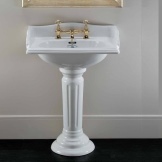



Standard models are made in the form of a semicircle or semi-oval and have a width in the range of 55-70 cm (most often 60 and 65) without taking into account additional side surfaces in multifunctional structures. In this range, you can pick up any model. There are also non-standard options for small sizes: from 45 to 50 cm and large-sized sinks - from 70 to 90 cm. There is not a very large selection in this list, and it is not so easy to find them on sale. It is not recommended to install large sinks in medium-sized bathrooms - in this case, users will feel permanently cramped. At the same time, some old buildings have such small dimensions of the bathroom that only models with a width of 40 and 30 cm can fit there - such options are called "office".


Tulips are usually produced with a stand height of 80 cm - this applies to traditional options with a column (keep in mind that sometimes this height may slightly differ from the accepted standard). In the case of half-tulips, the buyer himself decides at what distance from the floor to hang the sink.
Color solutions
The times when the shells were made in a single white version are long gone. Today the plumbing industry offers products in a wide variety of colors and shades.

Several models are most popular.
- Light beige - harmoniously fit into interiors decorated in warm colors, combined with natural stone and wood.
- Cream - make up an excellent composition with bathrooms lined with gray-brown or red-brown tiles, and also look original with white cabinets, glossy or matte finishes.
- Soft white - in their texture, such sinks resemble, rather, a delicate flower, add sophistication and sophistication to the entire bathroom interior, well complement any toilet design.
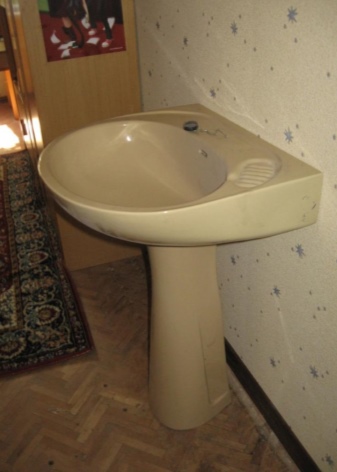

- Crystal white Is a classic of the genre, a universal color that looks aesthetically pleasing in combination with any textures, shades and stylistic elements.
- Cool shades of gray - are used to implement modern design, in harmony with chrome trim elements, and also favorably emphasize all kinds of beige tones.
- Warm shades of dark gray - an elegant solution that will allow you to add nobility and a certain aristocracy to the bathroom space, harmonizes well with stone and wood cladding.


- Salad shell - brings freshness and juiciness of a spring day to the bathroom decor.
- Deep black Is a bold move that may not be used in every home. The use of this shade assumes the thoughtfulness of the interior to the smallest detail, but at the same time, with the proper arrangement of the bathroom, it can become a real highlight of the room.


How to choose?
A little advice - before choosing a suitable model, measure the entire room well and draw up a plan for the placement of all the necessary elements (bathroom / cabinets / toilet) indicating their measurements - only in this case you can be sure that the purchased model will allow you to install all the other necessary installations and will create conditions for the most efficient use of the usable area of the bathroom.

At the time of making a purchase, special attention should be paid to the appearance of the product and its technical condition.
- Check the package contents. It may be necessary to additionally purchase a siphon, since manufacturers often complete sinks with additional materials of inadequate quality.
- Make sure the sink fits snugly against the pedestal. Try pushing the bowl - if it wobbles, then get a sink elsewhere. It is optimal to check the pedestal itself on a flat surface using a building level.
- Make sure the sink is free of cracks, chips, or other deformations.


Quality plumbing isn't cheap. At the same time, you purchase a sink once and for many years, and more often even for decades, so allow yourself a quality product from a well-established manufacturer. Remember, the miser pays twice, and trying to save money can result in additional costs.
Here is a small rating of the most popular manufacturers of sanitary ware, the quality of which has been tested by time.
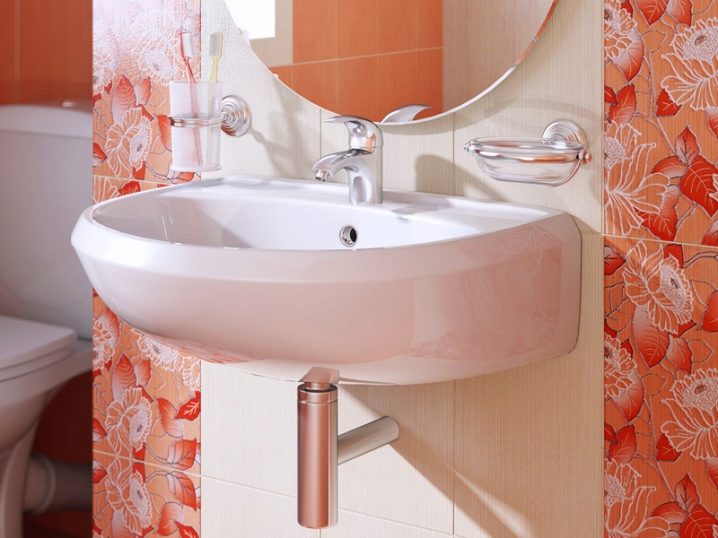
The most popular brand products among consumers all over the world Roca (Spain). This company specializes not only in the production of sanitary ware. The assortment list of products includes everything you need to equip bathrooms - mirrors, furniture, moisture-resistant accessories and more. The company has its own production facilities in many countries of the world, including Russia. This significantly reduces the cost of products and makes them affordable for our compatriots.
Tulip shells of this brand are made in corner versions, with or without a pedestal. As a rule, they are made of porcelain and earthenware, they have a classic color scheme and design.

Tulip shells from Jacob Delafon (France) are also in consistently high demand. The assortment line includes models of standard and corner washbasins, which are characterized by classic geometry. All products are made from ceramics.
Gustavsberg (Sweden) has been producing the highest quality sanitary ware for many years, which is popular in Scandinavia and far beyond its borders. Products of this brand are characterized by laconic design and ergonomic shape.
Jika (Czech Republic) is a brand that has gained fame for its low prices with a fairly high quality of product performance. The collections of the brand offer not only standard options, but also models for the disabled, as well as children's sinks. Faience is usually used as a material.

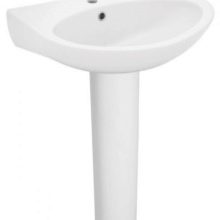

There are also very decent products in Russia. For example, an enterprise "Kirov ceramics" is considered one of the leaders of the domestic market. All products are of exceptional quality and affordable prices. The manufacturer's arsenal includes models of a wide variety of shades - blue, black, green and many others.
Oskol ceramics is another of our compatriots, all of whose products meet the highest European quality standards. The production is located in Stary Oskol at the facilities of an Italian company. All sinks of this brand belong to the middle price segment.


How to install?
To install a tulip sink, it is not at all necessary to resort to the services of professional plumbers - all work can be done independently, armed with the necessary tools:
- drill;
- a screwdriver;
- hammer;



- keys;
- a special siphon with an overflow drain option;
- level;
- grout.
Before starting work, it is necessary to completely dismantle the old washbasin, after turning off the water and disconnecting the drain. The sink itself can be easily unscrewed from the wall using wrenches of different sizes.
Next, you need to prepare a place for attaching a new sink. For this, all cement residues are removed from the walls, and the old holes are sealed with grouting.



After that, new holes are made, corresponding to the dimensions of the structure. The siphon is fixed to the footboard with special fasteners, and rubber washers must be used.Water can be connected only after installing the siphon, although many do exactly the opposite, and this is a big mistake - if the installation of the tulip is not done quite correctly, then you cannot avoid a small (or maybe large) flood.
At the very last stage, you may need help - the bowl is quite large and heavy, so you need a person who can hold it while you try to fix the installation. The nuts do not need to be tightened too much, as the leg still needs to be installed. To do this, raise the bowl slightly, fix the support and connect the drain hose at the final stage.
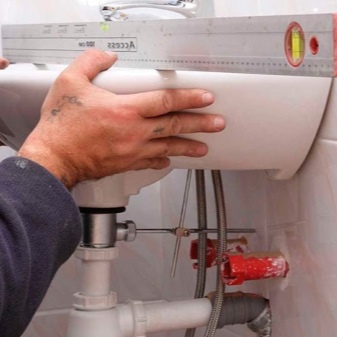

That's all - it remains only to clamp all the fasteners, and grease the junction of the support with the floor with grout or sealant.
For many decades, the tulip shell has remained the most popular and sought-after model. This is a classic option that is unlikely to go out of style in the coming years. That is why we can safely recommend such a design even to those strict consumers who are keenly following the latest trends in interior fashion.


Beautiful examples in the interior
The snow-white tulip sink will adorn any interior.


Models of color shades look original.


Corner options allow you to use the space as efficiently as possible.


Products are distinguished by sophistication and grace.




For information on how to install a tulip sink, see the next video.













The comment was sent successfully.